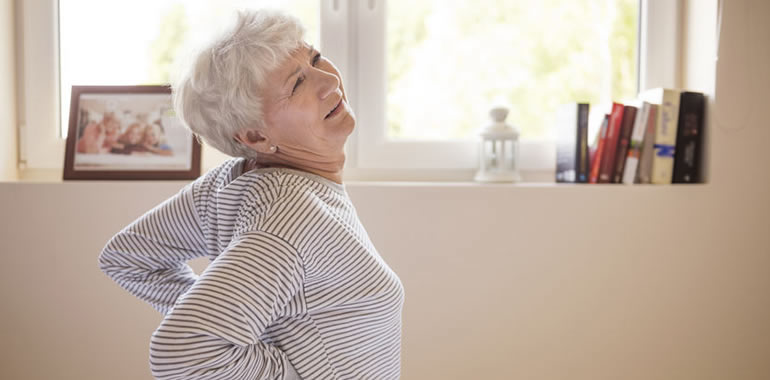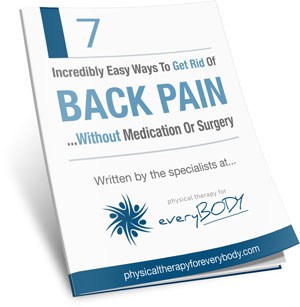
Low back pain is a pervasive and often debilitating condition that affects millions of people worldwide. Not knowing the root cause can increase stress and anxiety about your low back pain. Understanding the underlying structures that contribute to low back pain is crucial for effective management and peace of mind. You may find it easier to cope with your symptoms when you understand the root cause…and what you can do about it.
Today we will cover the five most common causes of low back pain, discuss the pain pattern associated with each cause, and give you some helpful tips to manage your low back pain.
The most common cause of low back pain is damage to the discs that separate the vertebrae.
Your spine is made up of vertebrae that stack on top of each other with discs situated between each vertebra. The vertebrae are responsible for supporting the upper body’s weight, providing flexibility, and protecting the delicate spinal cord. While the discs that are in between act as shock absorbers, allowing movement while preventing bone-on-bone contact.
As we age, the intervertebral discs often become damaged. Many people believe this is “just the way it is” as their family and friends suffered with disc problems as they aged. The truth is that every tissue in your body is designed to heal itself as long as it is moving correctly. The discs are no different. So discs can heal themselves to if you provide them with the correct movement.
Why are disc problems such a common cause of low back pain? After the age of 20 years old (approximately) we lose direct blood supply to the intervertebral discs of the spine. This makes it more difficult for the disc to get the nutrition it requires to heal. But don’t worry, the discs have been designed to use a process called imbibition to get the nutrition they need to stay healthy and heal from injury.
The structure of the disc is much like a sponge. When you rotate to the side, the sponge wrings out causing all the waste products to be eliminated. As you return to a neutral position then the disc is able to “suck up” nutrition from the surrounding region.
Simply rotating from side to side can cause your disc to receive the nutrition is requires for healing. Make sure you stay in the pain free range so that you don’t cause muscle tension which can compress the disc, decrease motion, and lead to degeneration.
When the discs are damaged or not working correctly, you may start to have increased stress on the facet joints of the vertebrae.
The next most common cause of low back pain is damage to the facet joints.
The facet joints, located at the back of the spine, play a crucial role in facilitating smooth movement and maintaining stability. These joints can become a source of low back pain when they have too much stress which leads to inflammation and formation of arthritis. You see, every joint in your body is lined with cartilage which is a mini shock absorber that allows the joint to glide smoothly.
When your cartilage gets damaged, your shock absorbers aren’t able to work correctly. This causes increased compression on the joints which will lead to arthritis formation over time. Eventually you may have pain, stiffness, and reduced mobility.
The good news is that the rotation motion that helped with your discs will also help with the cartilage in your facet joints. Rotation provides the correct stimulus to help the cartilage stay hydrated and continue doing it’s job of protecting your joints which decreases pain and improves motion.
Now, what if your low back pain started suddenly?
If you were fine one minute and had excruciating low back pain the next, then you are probably suffering with a muscle strain or ligament sprain. You see, the muscles and ligaments surrounding the lumbar spine provide essential support and add stability. Weak or imbalanced muscles can place undue stress on the spine which leads to pain and discomfort. Additionally, injuries or overuse of these muscles and ligament can result in strains and sprains, common culprits of low back pain.
You may be able to relate to Sarah, my patient who called me one Saturday morning while she was lying on the floor in agonizing pain after trying to plug in her vacuum cleaner. She didn’t know what to do about the pain and couldn’t get up from the floor. Her muscles had seized up and Sarah was having difficulty breathing due to the pain. I knew it had to be a muscle or ligament issue because of the quick onset so we talked through some deep breathing exercises and then I gave her a gentle exercise to help her back move pain free. She was able to get off the floor and even host a dinner party later that day!
Sarah was a regular patient due to neck and shoulder tension. When she arrived for her regular appointment, we decided to do a full evaluation of her low back, pelvis, and hips in order to determine what caused her muscle strain over the weekend. As you have learned today, it’s pretty easy to figure out WHAT tissue is causing the pain or problem. The work is in figuring out WHY this tissue became painful in the first place.
"But, Dr. Amy, my low back pain is causing pain all the way down to my leg!"
Earlier, we talked about how the vertebrae and the discs protect the delicate spinal cord that extends down the spine. The spinal cord gives rise to nerve roots that exit the spinal column through small openings between the vertebrae. These nerve roots can become compressed or irritated leading to pain, numbness, and tingling that radiates along the path of your affected nerve. In the low back, these nerve roots lead to pain down your leg and even into your foot.
The nerve root compression can be caused by bony changes such as lumbar spinal stenosis or osteoarthritis. These bony changes cause increased compression on the nerve roots leading to the symptoms down your leg.
The nerve roots can also get irritated by increased inflammation in the area which can be from arthritis, ligament strain, muscle sprain, or prolonged abnormal movements. This is why you need to find a Specialist who can determine not only the cause of your pain (which is the easy part!) but determine the reason why it happened in the first place.
Now, you might be saying to yourself “My low back pain is really low – like down in my buttocks”.
Then you might be suffering with sacroiliac joint dysfunction (SIJ dysfunction). The sacroiliac (SI) joints are situated at the base of the spine where the sacrum and iliac bones meet. These joints transfer the weight of the upper body to the pelvis and legs and are involved in various movements, including walking and standing.
Dysfunction in the SI joints, often caused by trauma, pregnancy, or inflammatory conditions, can lead to pain in the lower back and buttocks. Diagnosis of SIJ dysfunction can be challenging, as the symptoms often mimic other forms of low back pain. You also need help to determine if the SIJ dysfunction is causing problems further up the chain in the lumbar spine.
If you are thoroughly confused by this points, I don’t blame you! The low back is a very intricate system with many moving parts. You may have difficulty determining where this problem started and what steps you need to take to find healing. This is why it is critical to work with a Specialist, like we have here at Physical Therapy for everyBODY, to determine what is going on with your low back pain. Our Specialists will also help map out a plan to help your body heal so this pain does not come back.
Isn’t that what you always hear? Once you have low back pain it will come back. Well, yes, if you don’t change what caused the low back pain in the first place then it will come back again. But, if you work with a Specialist who can help you figure out what happened and what you can do about it, you can remain pain free into the future. If you would like to learn more about our system then we encourage you to schedule one of our Free Discovery Visits. During this Free Visit, we will discuss your particular story to see if you are a good fit for what we offer here at Physical Therapy for everyBODY.
Would you like to learn ideas that you can use right now to decrease your low back pain? Then download our free ebook 7 Incredibly Easy Strategies to Eliminate Your Low Back Pain Without Medication or Surgery.




